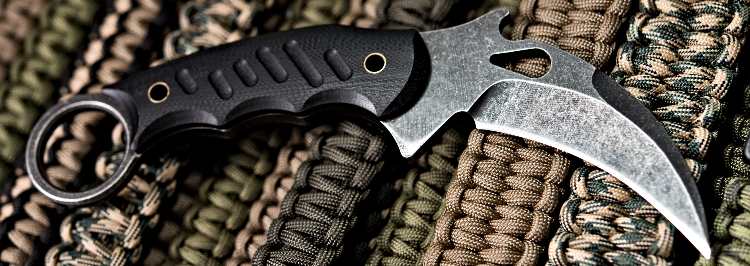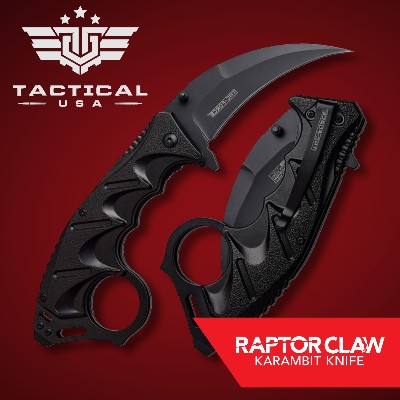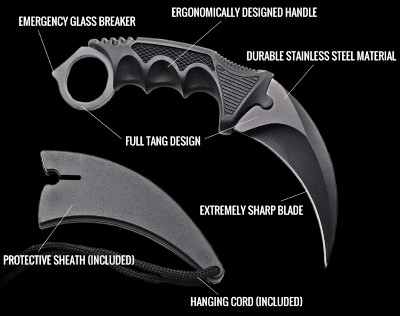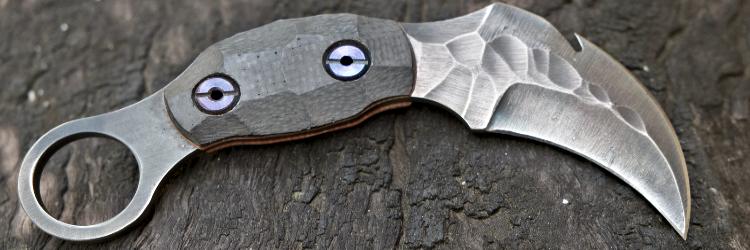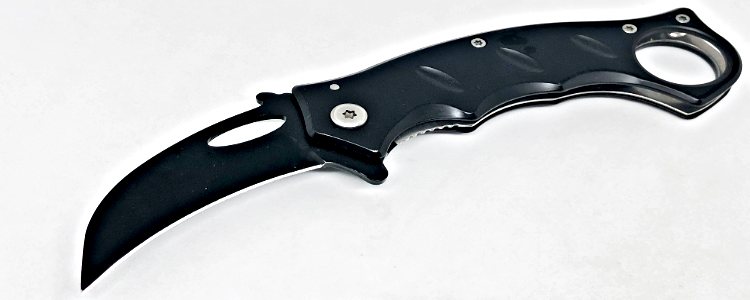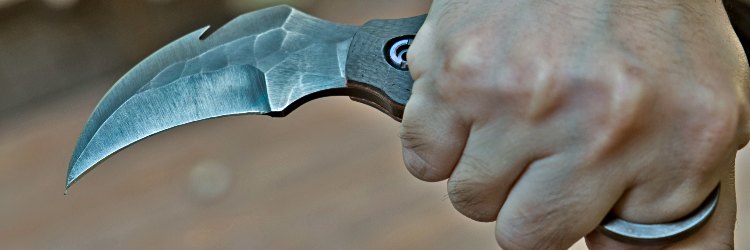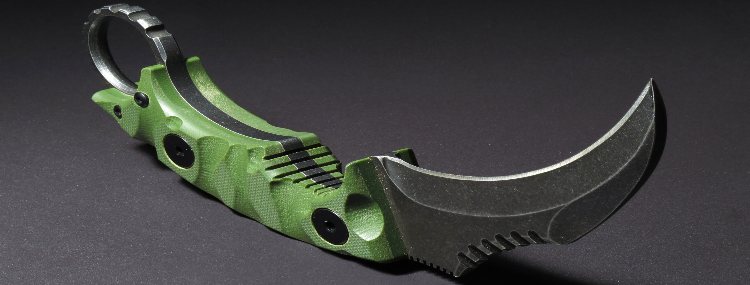 Skilled Survival’s Karambit Knife Buyers Guide
Skilled Survival’s Karambit Knife Buyers Guide
If you’re seeking information to find, use, or sharpen a Karambit Knife – you’ve come to the right place.
The karambit knife is one of the best blades you can wield in a knife fight.
It’s unique, it’s powerful, and it’s deadly. But like most things in life – “not all knives are created equal.”
Some are worth your money, but a handful are complete rubbish.
That’s why today, I’m going to share everything I know about the Karambit knives to help you get a knife you can be proud of.
Here are the specific topics I’ll be covering:
-
Best Karambit Knives On The Market Today
-
A Brief Karambit Knife History Lesson
-
What’s A Karambit Knife Anway?
-
Best Karambit Knife Uses
-
How To Fight With A Karambit Knife
-
Key Features To Look For In A Quality Karambit Knife
-
How To Sharpen A Karambit Knife To A Razors Edge
As A Way To Introduce You To Skilled Survival, We’re Giving Away Our Ultimate Survival Gear Checklist. Click Here To Get Your FREE Copy Of It.
Best Karambit Knives On The Market Today
Once you’re ready to choose a karambit knife, there are plenty of models on the market.
Folding Karambit Knife
If you want a compact karambit knife, you’ll want a folding blade that fits in your pocket.
But in any folding knife, the folding mechanism is the critical component. It’s the weak point – so make sure it’s reliable. And like most things in life, you get what you pay for…
This is why folding knives tend to be more expensive than a comparable quality fixed blade knife.
But they’re more compact and less conspicuous to carry, which is a big bonus in many EDC situations.
Spyderco Karahawk Specialty Knife
Many “tactical” karambit knives are way more extensive than necessary. But not so with the Spyderco Karahawk. This knife is both compact and efficient.
The folded 4.5” knife can fit into a pocket and can quick-draw to a full 6.5” when deployed.
While that sounds like only a 2” blade, the curved profile adds another 0.35” of sharpened edge to the knife. This extra blade length helps provide more leverage during close combat.
The blade is smooth and straightforward with no serrations or other features. This clean edge helps to keep sharpening it to a razor’s edge, a simple task.
The G10 epoxy/fiberglass scales provide an excellent grip. Plus, it’s impervious to chemicals and extreme temperatures.
The back of the blade features a positive hook (like the Emerson “Wave Opening” mechanism). As well as a large thumb slot to manually open the blade.
PROS
- Compact design is easy to conceal
- A reversible pocket clip allows for ambidextrous carry
CONS
- EXPENSIVE
- The shorter blade may not suit all fighting styles
FOX 479 G10 Black Emerson Wave Folding Karambit
Fox Knives has taken some design cues from Emerson. How? They’ve incorporated the “Wave Opening” feature. This feature makes for a swift draw opening from the pocket.
The adjustable pocket clip keeps the knife ready for a quick draw.
Better yet, try mounting it on either side of the handle. This setup makes it possible to use the Fox Karambit ambidextrously.
It features high-quality NC690Co stainless steel. This choice of steel has a very high hardness rating and holds an edge well.
Plus, the blade is dipped in a black Teflon coating to help inhibit corrosion. This coating cuts down even more on maintenance needs.
But keep in mind that any stainless steel blade is harder to sharpen than a carbon steel blade. And a karambit-style blade shape also adds complications.
If you do need to sharpen this blade, it will take some practice with proper sharpening tools.
PROS
- Corrosion-resistant stainless steel
- Wave Opening feature
CONS
- Harder to sharpen due to stainless blade and karambit shape
CRKT Provoke Kinematic EDC Karambit Knife
Most folding blades have a single pivot point. These pivot points open like a hinge from one end. But the CRKT Provoke karambit proves there ARE other ways to make a folding knife.
The Provoke uses a unique 4-bar linkage that extends, rather than folds, the blade.
This extending motion allows you to grasp the handle with a death grip – even while pushing down on the activation point and deploying the blade.
The Provoke Karambit also sports a deep-carry pocket clip. This clip is an unusual feature on a karambit blade due to the position of the finger hole.
So you can carry the knife even deeper down in your pocket. This knife feature allows the knife to completely disappear into the frame of the knife when not in use. And this makes for a more comfortable handle.
PROS
- Deep carry pocket clip
- Fast deployment with secure grip throughout
CONS
- The pocket clip is not adjustable for left-handed carry
- The complex folding mechanism requires more maintenance
Smith & Wesson ExtremeOps CK33 7.9in S.S. Karambit Folding Knife
While most of us know Smith & Wesson from their firearms, they have long produced a line of knives as well.
The ExtremeOps CK33 is a great starter option to discover if a folding karambit knife will work for your needs.
It has a generous 3” blade of 7Cr17MoV stainless steel, making it simple to maintain.
The curvature isn’t too extreme, so it will feel comfortable for those who are familiar with western styles of blades.
It also features a pocket clip and ambidextrous thumb knob to help open the blade quickly. But the pocket clip position on the knife is upside down (finger hole at the bottom of the pocket). This unique design is not as intuitive.
PROS
- Affordable
- Easy to use and maintain
CONS
- Some play in the folding mechanism
- Somewhat heavy for the size
- The pocket clip holds the knife in the “wrong” (tip down) position
The Tactical Karambit Knife
The Raptor Claw Folding Karambit consists of a 2.5″ stainless steel blade and a 5.25″ black handle.
It also includes a lightning-fast, spring-assisted opening mechanism for a quick draw. This is important in a self-defense bladed weapon.
It also has a robust pocket clip design that allows you to place it discretely deep down in your pocket. This specialty pocket knife allows you to easily keep it with you every day and everywhere.
And at the time this article was published, you could get this quality karambit knife for FREE – just pay a reasonable shipping/handling fee. Click here now, to see if this deal is still available.
PROS
- Affordable (FREE +s/h)
- Spring-assisted opening mechanism
CONS
- Finger ring can get snagged when pulled out of pocket
Fixed-Blade Karambit Knives
As appealing as a folding karambit knife seems at first, it always has a critical path of failure in the mechanism.
Are you familiar with the KISS principle (Keep It Simple, Stupid!)? If so, you’ll understand – the more straightforward a tool is, the less likely it is to fail.
For this reason, many people prefer a full-tang fixed blade karambit knife for hand-to-hand combat.
This robust, one-piece build leaves little in the way of weakness.
CRKT Du Hoc Fixed Blade Knife with Sheath
Columbia River Knife Works makes some top-rated and well-built knives. I especially like their Du Hoc karambit blade.
The high-carbon SK5 steel has a great balance of toughness and edge holding ability. It has a full-tang design of nearly 10” from point to tail.
Attached to this massive chunk of steel is a highly-textured G10 handle. This handle is perfect for optimal grip performance in all conditions.
The handle scales attach with a pair of hollow rivets. This attachment setup allows a space to thread paracord through the rivets. This, in turn, allows the knife to be an attachment to a spear shaft for extra reach.
The Du Hoc also comes with a secure glass-reinforced nylon sheath.
PROS
- Simple design with minimal complications
- High-end materials ensure durability
CONS
- The large size makes it very noticeable
- The sharpened back edge point may not be legal in all locations
Schrade 9Cr18MoV Grey Ti Coated Karambit
The SCH111 from Schrade is about as simple as a knife can get – it’s one piece of steel with no frills.
This design makes the knife extremely lightweight and durable, but not the most comfortable.
Like many skeleton handle blades, the SCH111 has an open center. This setup allows for a reduction in weight. But it also makes it possible to weave in a paracord handle for grip and secondary utility.
The skeleton handle also makes it straightforward to attach the SCH111 as a spear point.
The high-quality stainless steel makes for a durable and maintenance-free knife. This steel choice is a plus if you plan to store the blade in a survival cache for emergencies.
PROS
- Lightweight, simple build
- Low maintenance needs
CONS
- Handle (or lack of) makes the knife uncomfortable in the hand
Schrade 8Cr13MoV Grey Ti Coated Full Tang Fixed Blade
The SCH112 is another excellent knife from Schrade. And the SCH112 is a very different knife than the SCH111.
Where the previous knife was a compact skeleton design, the SCH112 has a large, 5.2-inch blade. And it has a grippy, rubberized elastomer handle.
It’s one piece of 8CR13MoV stainless steel, from the highly curved point to the large finger ring at the base.
One thing to watch out for is the sheath. The extreme curvature of the blade can expose your fingers during unsheathing.
This exposure is even more dangerous because the blade is sharp on both sides. But this also makes it more deadly – and thus, illegal to carry in many locations.
PROS
- Well-made and durable
- Sharp out-of-the-box
CONS
- Extreme curve to blade makes it dangerous for novice users
- Sheath makes it difficult to remove safely
- It May NOT be legal where you live
Cold Steel Steel Tiger Karambit
Cold Steel makes a wide variety of affordable bladed tools, from knives to axes and even swords.
The Steel Tiger karambit is an excellent entry blade. It comes with an ergonomic handle and a less aggressive curve than the Shrade SCH112.
With a 4.75” blade and a large Kray-Ex rubberized handle, it’s easy to use and far safer for new users.
If you’re learning how to use a karambit, get the matching blunt-pointed trainer as well!
PROS
- Affordable and well made
- Sharp out-of-the-box
- Only sharpened on one side, which is far easier to carry legally
CONS
- The sheath isn’t MOLLE compatible
Ape Survival’s Black Karambit Knife
Here’s a solid full tang black karambit knife from Ape Survival.
This karambit knife is not too big and not too small with an overall length of 7.4 inches.
It includes a handle with molded finger grips and a finger ring as well. Plus, the finger ring has a pointed end for more effective hammering moves.
Now, this is NOT a high-end karambit knife but it is very good for the price…
As we say often with survival gear, you get what you pay for, but what happens when the offer is FREE?
We’ll then it’s a pretty low risk – high reward “purchase”. Because at the time this article was published, you could get this Karambit Knife for FREE – just pay a reasonable shipping/handling fee. Click here now, to see if this deal is still available.
PROS
- Full tang construction
- Grip Includes finger molding for superior grip
- Sheath included
- FREE (+ s/h)
CONS
- The sheath is not MOLLE compatible
- Needs some sharpening before use
As A Way To Introduce You To Skilled Survival, We’re Giving Away Our #78 Item Complete Prepper Checklist. Click Here To Get Your FREE Copy Of It.
A Brief Karambit Knife History Lesson
It’s a fact of human nature that conflicts arise. And every culture develops its own particular weapons to defend itself.
Most modern weapons (i.e., guns) tend to take on a similar design. But if you look back at the traditional bladed weapons of a culture, it’ll tell you a lot more about what makes them unique.
For example, in the jungles of Southeast Asia, humans are not always at the top of the food chain. Both leopards and tigers hold dominance in pockets of pristine habitat.
These big cats hold a place of reverence, in dense jungles, and in the minds of native people.
So it’s no wonder that one of the most storied fighting knives from this area takes the shape of a tiger claw!
As A Way To Introduce You To Skilled Survival, We’re Giving Away Our #78 Item Complete Prepper Checklist. Click Here To Get Your FREE Copy Of It.
What’s A Karambit Knife Anyway?
The karambit is a compact fighting knife – one with a distinct forward sweeping blade that ends at a point.
The blade shape likely developed in Western Sumatra. It may have stemmed from modifications to a small handheld farm tool. Why? Because a similar tool was used to cut and rake roots and thresh and plant rice.
A karambit is similar in design to a small sickle, but with a more open hook to the blade.
Once invented, it spread throughout Southeast Asia over the coming centuries. It became a common and popular weapon for the peasant class in the region.
As A Way To Introduce You To Skilled Survival, We’re Giving Away Our Ultimate Survival Gear Checklist. Click Here To Get Your FREE Copy Of It.
Best Karambit Knife Uses
Despite its humble beginnings, the karambit developed into a fearsome fighting tool – one with a reputation for being brutally effective.
The karambit knife is the main blade of choice in many warrior cultures of the region. It’s also commonly used in Filipino martial arts.
It’s still considered one of the deadliest melee weapons of all time.
The unique design of the karambit has made it a favorite for hand-to-hand combat instructors. Many believe it has a more intuitive striking ability than alternative fighting knives.
If you’re looking for a real fighting knife, the karambit might be your best choice.
The forward sweep of the blade is reminiscent of a tiger’s claw. It hooks and digs into an enemy, rather than slicing along the skin.
The sharp point focuses all its striking energy on one spot. This design helps it penetrate deep through clothing, armor, and tissue alike.
And once it penetrates the surface, the blade will naturally dig even deeper when a victim tries to pull away.
Stop and think about THAT – NASTY!
This automatic “deepening of the blade” results in devastating injuries, especially if the attack focuses on the weakest points of a body.
Here’s a video of a small karambit knife slicing through meats to give you an idea of how much damage these knives can inflict!
Beyond the distinct forward-curved blade, Karambit knives often include a large finger loop in the handle.
The addition of the finger loop allows for a solid grasp of the knife with either hand. And many blade masters have taken advantage of this by learning to fight with one in each hand.
Not only that, but many karambit blades work in both an upward or downward grip position.
Most karambit knives feature “enclosed” finger loops (as opposed to open ones). This closed-loop design helps to keep the blade secure in these different grips.
This loop can wrap around either the index or little finger, depending on the vertical orientation of the hold. This “locked-in” grip allows for powerful cutting strikes from any direction.
It also allows for a protected “hammer” strike as well, using the metal loop as a striking point. Many karambit knives include a small point as a part of the loop; this makes a downward hammer blow deadly.
With a blade so focused on fighting, it’s not as versatile as other knives for daily tasks.
For example, ordinary camp chores (i.e., food and firewood prep) are more complicated with a karambit. Why? Because it’s tricky to use the sharpened curved edge for such delicate peeling and slicing tasks. And it’s not made for chopping or batoning wood either.
It does, however, work brilliantly in some specific tasks such as cutting rope, vines, and other tough-to-slice items.
As A Way To Introduce You To Skilled Survival, We’re Giving Away Our #78 Item Complete Prepper Checklist. Click Here To Get Your FREE Copy Of It.
How To Fight With A Karambit Knife
Effectively fighting with a karambit blade takes serious training. But intense training is necessary even if you train with other slicing blades in the past.
Why? Because the fighting styles are so unique to the karambit.
So if you want to master the karambit style of fighting, it’s best to seek a professional. Look for someone who specializes in karambit knives from a martial art instructor familiar with Filipino methods.
But you can start with some basic training instruction online and buy training blades online (rubber blades with blunted tips).
First, you need to understand the various grips common to karambit fighting techniques – here’s a brief overview of one, to get you started.
Reverse And Forward Grips
The Reverse and Forward grips are most common. But others allow for more reach or to disorient your opponent.
Paul Ingrahm produces some of the best instructional karambit videos in recent years. He’s an expert instructor at the Kali Center or Luke Holloway at Raw Combat International.
Once you understand the different grips, tackle each one slowly. Make sure you’re comfortable with each style of attack and defense before moving on.
Many of these knife drills need a partner to master. A partner allows you to perform repetitions until they become second nature.
After you have mastered basic moves, there are plenty of advanced strikes to tackle. Many of these advanced moves prove deadly in combat.
Most of these involve short, high-energy strikes. Attacks look more like boxing than a traditional knife fight.
This setup is due to the frequent use of the reverse grip, which allows you to “punch” the hooked blade forward.
Here are a couple of combo moves to get a sense of what’s possible with a Karambit IF you learn how to use it.
As A Way To Introduce You To Skilled Survival, We’re Giving Away Our Ultimate Survival Gear Checklist. Click Here To Get Your FREE Copy Of It.
Best Karambit Knife Features
As with any other critical piece of gear, it pays to invest in quality.
A Quality Blade Material
The steel chosen for a knife blade is the most critical part of the entire knife. You can’t have a good knife if its steel is of poor quality.
But there are plenty of different “high-quality” steels on the market. So you’ll have to choose between two main steel types:
1. High-carbon
Pros/Cons Summary: It’s easy to sharpen to a fine edge but requires maintenance and corrosion prevention.
2. Stainless steel
Pros/Cons Summary: It needs very little maintenance and holds an edge well, but it’s hard to sharpen and can be brittle.
So your steel preference depends mainly on your skills and diligence in maintaining your blade. There is no right or wrong answer, just make sure to buy a high-quality metal no matter which path you choose.
A Quality Handle
The handle should be comfortable in either forward or reverse grips. And the finger ring should comfortably fit over both your index and little fingers.
Some people like the handle to have molded finger position slots to help with the proper grip and finger placements.
It shouldn’t be too snug, as that may prevent you from changing grips if needed.
Quality Construction
Ensure the blade and handle are securely connected. And any extra design features (pocket clip, folding mechanism, etc.) are well-constructed.
Full tang is always more robust than partial tangs or a folding karambit knife with hinges.
But, on the other hand, a folding karambit knife is more convenient to carry.
Blade Length And Angle
A karambit’s shape is always forward sweeping, but there are variations on blade length and angle.
- Longer blades are more deadly in combat but more challenging to carry and conceal.
- Shorter blades have less reach but can fit comfortably in a pocket.
You should also consider whether you intend to carry the blade concealed or not. And whether you want a folding karambit knife to carry in a pocket or a fixed blade that needs a sheath.
A Cautionary Note On “Karambit” Blades
Over the years, I’ve run across several blades that claim to be a karambit but are a back-swept design.
These may be fine blades. But you should be aware that they are fundamentally different knives.
These are, by definition, *NOT* karambit’s and do not function (or fight) the same way.
As A Way To Introduce You To Skilled Survival, We’re Giving Away Our #78 Item Complete Prepper Checklist. Click Here To Get Your FREE Copy Of It.
How To Sharpen A Karambit Knife to A Razors Edge
Due to the inward curving blade on a karambit knife, you can’t effectively sharpen it with a flat stone or pocket knife sharpener.
Instead, a karambit requires a curved surface such as a diamond honing cone or a gouge sharpener.
This video shows how to sharpen a karambit blade using a rounded whetstone and strops. It uses a DIY base that you can make yourself.
When you decide to sharpen your karambit blade, work slowly at first. Make sure you have the proper technique down, and you’re not causing damage to the edge in the process.
Once you’ve successfully sharpened the blade a few times, it will become muscle memory. You’ll quickly settle into an efficient sharpening technique.
And there’s nothing more satisfying than putting (and keeping) a razor-sharp edge on ALL your bladed tools.
Final Thoughts
One of the things that separate humans from nearly all large land predators is the lack of claws.
But with a karambit knife, you can rectify that oversight. You can give yourself a devastating claw-inspired hand-to-hand combat weapon. The karambit is a weapon that’s incredibly versatile and deadly (if you know how to use it).
Sure, it will never match the camp utility of a survival knife or bowie knife. But a karambit is a valuable tool to have in your arsenal.
Jason K.
P.s. Do you know where the closest nuclear bunker is from your home?
There are a lot of natural nuclear shelters in the US that are absolutely free. And one of them is near your home.
Click here to see the Closest Natural Nuclear Bunker to Your Home?
Click on the image above to find out where you need to take shelter.
The post Best Karambit Knives For Serious Self Defense appeared first on Skilled Survival.


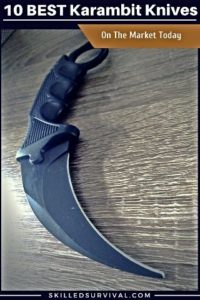
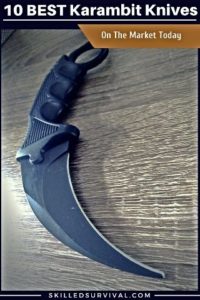 Skilled Survival’s Karambit Knife Buyers Guide
Skilled Survival’s Karambit Knife Buyers Guide